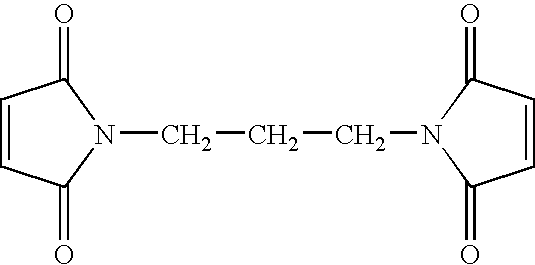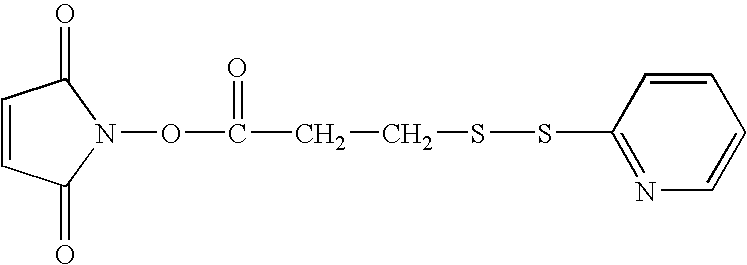Biological indicator
- Summary
- Abstract
- Description
- Claims
- Application Information
AI Technical Summary
Benefits of technology
Problems solved by technology
Method used
Image
Examples
example 1a
[0053] A substrate is utilized containing an amine terminated surface, whether manufactured with the functionality such as a glass or a polystyrene substrate, or modified using a self-assembled monolayer with the desired end group or treated by some physical or chemical means to release or make accessible functional groups. A heterobifunctional crosslinking reagent, N-succinimidyl 3-(2-pyridyldithio)propionate (SPDP), is reacted to the amine terminated surface in phosphate buffered saline for 30-60 minutes (a 20 mM SPDP stock solution is made in either DMSO or EtOH) at temperatures preferably between 17° C.-40° C. All excess SPDP is removed by rinsing in phosphate buffer. The surface is then reduced using dithiothreitol (DTT) for approximately 30 minutes. Geobacillus stearothermophilus spores are then reacted with the reduced surface for a length of time from about 1 second to about 18 hours. Moreover, the spore is covalently bonded to the crosslinking agent which in turn is covalen...
example 1b
Thiolation of a Spore
[0054] A spore solution of 106 to 109 cfu / mL is formulated with a PBS solution. A 120 μL aliquot of 20 mM SPDP is added to 0.5 mL of the spore suspension. (The solutions can be scaled up as appropriate.) The SPDP is then reacted with the spores for a period of 1 second to about 2 hours, with between 1 second and 30 minutes being preferred. The amine reactive group of the SPDP, N-hydroxysuccinimide (NHS) will react with available amines in the proteins of the spore coat. The unreacted SPDP is then removed using typical methods such as dialysis, filtration, or both, or other means known to those skilled in the art. Following separation of the unreacted SPDP, the newly thiolated spores are brought in contact with a surface that has been pre-modified with SPDP (following the same methodology as used in other examples) and subsequently reduced. The spore will then react with the surface creating a covalently linkage through a disulfide bound.
example 2
[0055] Using a substrate with native hydroxyl functional groups (or a polymeric surface that has been treated with gas plasma to create hydroxyl functionalities at the surface), the heterobifunctional reagent, N-(p-Maleimidophenyl) isocyanate (PMPI), is reacted to the surface containing hydroxyl groups in a non-hydroxylic buffer at alkaline pH for 30 minutes (a PMPI stock solution is made in either DMSO or DMF at an approximately 10-fold molar excess over the concentration of hydroxyls present at the surface). The isocyanate end group of the PMPI is then reacted with the hydroxyl molecules on the surface of the substrate to form urethane linkages. The sulfhydryl groups present on the spores Geobacillus stearothermophilus are then reacted with the maleimide functional end of the crosslinker at a neutral pH for a period of 2 hours at room temperature. The heterobifunctional crosslinking reagent is covalently bonded to the spores and to the hydroxyl groups of the subs...
PUM
 Login to View More
Login to View More Abstract
Description
Claims
Application Information
 Login to View More
Login to View More - R&D
- Intellectual Property
- Life Sciences
- Materials
- Tech Scout
- Unparalleled Data Quality
- Higher Quality Content
- 60% Fewer Hallucinations
Browse by: Latest US Patents, China's latest patents, Technical Efficacy Thesaurus, Application Domain, Technology Topic, Popular Technical Reports.
© 2025 PatSnap. All rights reserved.Legal|Privacy policy|Modern Slavery Act Transparency Statement|Sitemap|About US| Contact US: help@patsnap.com



